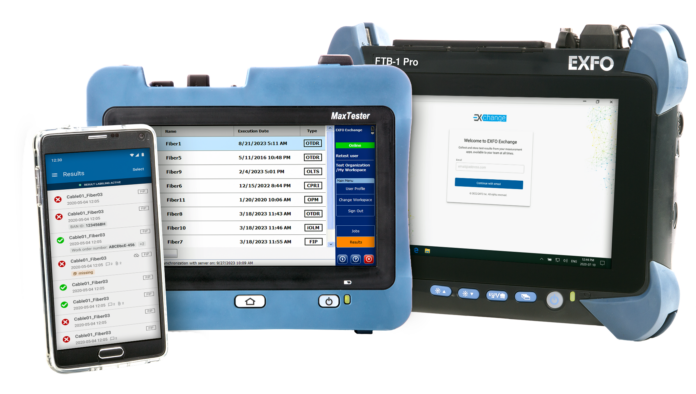Test equipment company EXFO has introduced a new cloud-based reporting platform, Exchange, which enables data from its equipment to be directly reported to and analyzed in the cloud.
EXFO Exchange provides real-time visibility into field operations and processes, and it supports increased process automation, a central home and organization framework for data, the company said, as well as enabling better collaboration across network testing teams that are likely to be spread out across an entire country.
During a recent interview at EXFO’s offices in Montreal, Canada, Sophie Legault, EXFO’s director of product management, said that some of the company’s customers have already been using Exchange. They have been pleased with the increased visibility into what work has been done and what remains to do, she said. “It increases collaboration, especially in the wireless space where you have the Tier 1s that work with a lot of contractors,” Legault added. “They have work being done by different contractors in different areas, and in Exchange, the contractors can construct and upload the turn-up results, and the carriers see the progress of the turn-up, or troubleshooting, on the fly.”
Customers who have had early access to Exchange told the company that for the first time, they were getting timely visibility into field teams’ work, how much they were doing and the quality of the work, so that they could make decisions based on that data, Legault said.
Exchange also offers faster and more efficient processes, she explained, because the typical process for transferring test results from the equipment used by local teams is for it to be saved on a USB drive and then emailed. “It’s a very manual process and takes a lot of time,” Legault said. Exchange will automatically send test data to the cloud, where a manager or a customer can access results directly. Faster reporting and confirmation of successful site deployment means that contractors get paid faster as well, she pointed out: Contractors don’t have to spend multiple days on site and then spend more time on reporting, it’s all in the cloud already, and they just have to notify a client that the data is there.
Exchange also supports automated workflow capabilities, ensuring that all the steps of a test are done properly. This “helps in terms of ease of use,” Legault said, as well as reducing inefficiencies in field testing because it lays out the process for a tech in order to make sure they are following the same, standardized procedures each time. It also means that even if there is a lag of months between when a site is constructed and when it is turned up, the related data is easily accessible if a problem surfaces later, Legault said.
As a centralized, structured data collection repository, Exchange also offers a chance for a better large-scale view of deployment and infrastructure trends, Legault said. One key thing that EXFO has observed, she said, is that carriers increasingly want to make better use of their data. Typically, she said, once site test data was submitted, carriers looked at it once and didn’t come back to it after the fact to figure out trends or issues—or they simply could not do so because of disparate, manual data submissions. With Exchange providing a structured data set to analyze, “they can look at trends, they can look at what’s going well in the network, or what contractor needs more training. You can leverage all of that data, looking at where CapEx is going. … It gives intelligence in terms of the CapEx that they’ve spent, and if it’s leveraged properly.”
Such standardized, structured data reporting and visibility is also increasing important as 5G matures, Legault said. In the initial rush of deployment, some site issues, such a passive intermodulation, didn’t matter as much because there were a small number of customers and a limited amount of bandwidth involved, she said. Now that it’s being operationalized, those issues have to be addressed because customer experience can be impacted—so carriers are demanding better understanding of what’s happening in the network, Legault said. “It’s really ramping up, and [now carriers] need help in terms of maintaining the network and making sure that the KPIs are at the right level,” she said. And with 5G CapEx budgets coming down, efficient deployment and maintenance is also paramount.
The company has posted a number of how-to videos explaining the process for connecting devices with an Exchange account, configuration and generating reports from test results.

